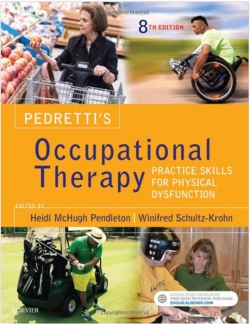
Pedretti’s Occupational Therapy: Practice Skills for Physical Dysfunction, 8th Edition prepares you for
occupational therapy practice with adults who have physical disabilities.
This cornerstone text provides a foundation for the development of clinical reasoning skills in a comprehensive,
case-based learning approach to physical dysfunction.
New full color photos and helpful pedagogy, including threaded case studies, OT Practice Notes, ethical
considerations, and end-of-chapter review questions, reinforce learning, enhance retention, and prompt you to apply
principles in a clinical setting.
practice.
practice ethically.
practice area in the 21st century.
role in patient care.
chapter.
OTPF-3 and its relationship to the practice of occupational therapy with adults who have physical disabilities.
of intervention occupational therapists can provide.
occupational therapy; describes the role of the occupational therapist with this population within the parameters of
the third edition of the Occupational Therapy Practice Framework (OTPF-3); and recommends clinician self-care
strategies to support ongoing quality care.
care; independent living skills; short- and long-term equipment needs; environmental accessibility; and educational,
work, and leisure activities. It looks at how the occupational therapist offers emotional support and intervention
during every phase of the rehabilitation program.
therapist including: anatomy; client evaluation; interventions areas; client-centered occupational therapy analysis;
and intervention strategies for frequently impacted occupations.
wellness and productive aging, then moving to occupation and participation in meaningful activity and finally,
highlighting body functions and structures which have the potential to physiologically decline as a person ages.
devices available in today’s marketplace, such as robot-assisted therapy, to support the weak upper extremity.
photos to better illustrate how to perform these key procedures.
keloid scars, silver infused dressings, biosynthetic products, the reconstructive phase of rehabilitation, and
patient education.
a new threaded case study on "Daniel", a 19-year-old combat engineer in the United States Army who suffered the
traumatic amputation of his non-dominant left upper extremity below the elbow.
Part 1: Overview: Occupational Therapy Foundations for Physical Dysfunction
1. The Occupational Therapy Practice Framework and the Practice of Occupational Therapy for Persons with Physical
Disabilities
2. History and Practice Trends in the Treatment of Physical Dysfunction
Part 2: Occupational Therapy Process and Practice
3. Application of the Occupational Therapy Practice Framework to Physical Dysfunction
4. Evidence-Based Practice for OT
5. Health Promotion and Well-Being for People with Physical Disabilities
6. Personal and Social Contexts of Disability: Implications for Occupational Therapists
7. Teaching Activities in Occupational Therapy
8. Documentation of Occupational Therapy Services
9. Infection Control and Safety Issues in the Clinic
Part 3: Occupational Performance and the Performance Areas: Evaluation and Intervention
10. Activities of Daily Living
11. Mobility
12. Sexuality and Physical Dysfunction
13. Sleep and Rest
14. Work Evaluation and Work Programs
15. Americans with Disabilities Act and Related Laws that Promote Participation in Work, Leisure, and Activities of
Daily Living
16. Leisure Occupations
17. Assistive Technology
Part 4: Performance Skills and Client Factors: Evaluation and Intervention
18. Performance Skills: Definitions and Evaluation in the Context of the Occupational Therapy Practice Framework
19. Evaluation of Motor Control
20. Occupation-Based Functional Motion Assessment
21. Joint Range of Motion
22. Evaluation of Muscle Strength
23. Evaluation of Sensation and Intervention for Sensory Dysfunction
24. Evaluation and Treatment of Visual Deficits After Brain Injury
25. Evaluation and Intervention of Perception Dysfunction
26. Evaluation and Treatment of Limited Occupational Performance Secondary to Cognitive Dysfunction
27. Eating and Swallowing
28. Pain Management
Part 5: The Occupational Therapy Process: Implementation of Intervention
29. Therapeutic Occupations and Modalities
30. Orthotics
31. Traditional Sensorimotor Approaches to Intervention
32. Motor Learning
Part 6: Intervention Applications
33. Cerebrovascular Accident(Stroke)
34. Traumatic Brain Injury
35. Degenerative Diseases of the Central Nervous System
36. Spinal Cord Injury
37. Disorders of the Motor Unit
38. Arthritis
39. Hand and Upper Extremity Injuries
40. Orthopedic Condition: Hip Fractures and Hip, Knee, and Shoulder Replacements
41. Low Back Pain
42. Burns and Burn Rehabilitation
43. Amputations and Prosthetics
44. Cardiac and Pulmonary Diseases
45. Cancer and Oncology Rehabilitation
46. Special Needs of the Older Adult
47. HIV Infection and AIDS
48. Polytrauma and Occupational Therapy
49. Occupational Therapy in Hospice and Palliative Care


